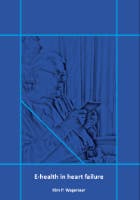Kim Wagenaar
E-health in heart failure

- Datum
- (Co) promotoren
- 23-03-2017
- prof.dr. A.W. Hoes, prof.dr. T. Jaarsma, dr. F.H. Rutten, dr. B.D.L. Broekhuizen
Samenvatting
Aim: The aim of this thesis was to study the effect and the cost-effectiveness of two e-health interventions, of which one included replacement of usual care by e-health, on self-care in heart failure (HF) patients by conducting the e-Vita HF study. In addition, we evaluated the interpretation of the self-care results of the study and their generalizability. Finally, we described the worldwide use of one of the e-health tools studied. Methods: The e-Vita HF study was a three arm randomized controlled trial, with 12 months follow-up. Group 1 received usual care; group 2 usual care plus the heartfailurematters.org website, an information website on HF; and group 3 received the e-health adjusted care pathway with a platform for disease management, including telemonitoring facilities, which replaced routine consultations with HF nurses at the outpatient clinic. Patients were included if they had a confirmed diagnosis of HF for at least 3 months. The primary outcome was self-care as measured by the European Heart Failure Self-care Behavioural scale (EHFScB scale). Secondary outcomes were hospitalisation, mortality and cost-effectiveness. Results: In total, 450 patients participated from 9 Dutch HF outpatient clinics. The mean age was 66.8 (SD 11.0) years, 74.2% were male, and 78.8% classified as NYHA I or II at baseline. After 3 months follow-up, the mean score on the self-care scale was significantly higher in the groups using the website and the adjusted care pathway compared to usual care: 73.5 vs. 70.8 (difference 2.7, 95%CI 0.6 – 6.2), and 78.2 vs. 70.8 (difference 7.4, 95%CI 3.8 – 9.4), respectively. The effect attenuated during follow-up into no differences between the groups after one year. Hospitalisation and mortality did not clearly differ between the groups. Regarding cost-effectiveness, the mean health quality-adjusted life years (QALYs) (range 0-1) were 0.73, 0.74, 0.76 QALY for the usual care, website, and e-health adjusted care pathway group, respectively. The corresponding mean costs per patient were €5,741, €4,865, and €5,111. The comparison between participants and nonparticipants in the e-Vita HF study showed that participants were younger (mean age 66.7 vs 73.4 years, p< .001), more often male (75% vs. 58%, p< .001), and had in general fewer comorbidities. After adjustment, SES was significantly higher in participants compared to nonparticipants. The analysis on interpretation of the self-care results showed that a single threshold of 70 accurately discriminated between patients with adequate and inadequate self-care. Finally, worldwide the annual number of sessions to the e-health tool heartfailurematters.org increased from 416,345 in 2010 to 1,636,368 in 2015. Conclusions: Both the heartfailurematters.org website, and an e-health adjusted care pathway improved self-care in HF patients on the short-term (3 months). Implementing the heartfailurematters.org website in HF outpatient care results in a small increase in health effects while reducing costs. The e-health adjusted care pathway may provide an additional health effect at modest extra costs. The fact that participants of the trial were more healthy and wealthy than nonparticipants limits generalisation to all patients with HF. Finally, the heartfailurematters.org is widely used, with ever increasing visiting numbers.
